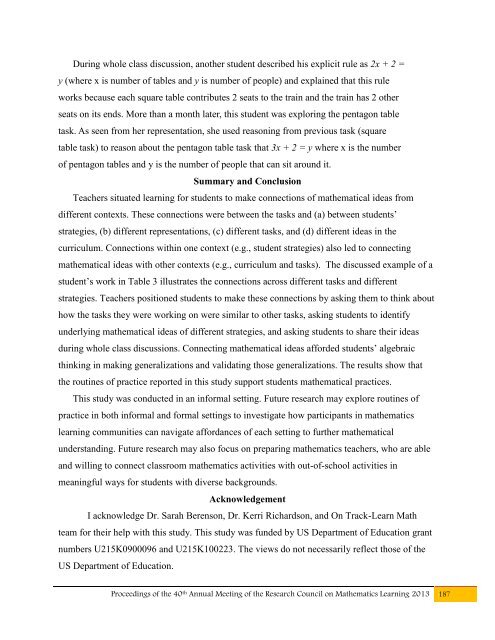2013 Conference Proceedings - University of Nevada, Las Vegas
2013 Conference Proceedings - University of Nevada, Las Vegas
2013 Conference Proceedings - University of Nevada, Las Vegas
- No tags were found...
Create successful ePaper yourself
Turn your PDF publications into a flip-book with our unique Google optimized e-Paper software.
During whole class discussion, another student described his explicit rule as 2x + 2 =y (where x is number <strong>of</strong> tables and y is number <strong>of</strong> people) and explained that this ruleworks because each square table contributes 2 seats to the train and the train has 2 otherseats on its ends. More than a month later, this student was exploring the pentagon tabletask. As seen from her representation, she used reasoning from previous task (squaretable task) to reason about the pentagon table task that 3x + 2 = y where x is the number<strong>of</strong> pentagon tables and y is the number <strong>of</strong> people that can sit around it.Summary and ConclusionTeachers situated learning for students to make connections <strong>of</strong> mathematical ideas fromdifferent contexts. These connections were between the tasks and (a) between students’strategies, (b) different representations, (c) different tasks, and (d) different ideas in thecurriculum. Connections within one context (e.g., student strategies) also led to connectingmathematical ideas with other contexts (e.g., curriculum and tasks). The discussed example <strong>of</strong> astudent’s work in Table 3 illustrates the connections across different tasks and differentstrategies. Teachers positioned students to make these connections by asking them to think abouthow the tasks they were working on were similar to other tasks, asking students to identifyunderlying mathematical ideas <strong>of</strong> different strategies, and asking students to share their ideasduring whole class discussions. Connecting mathematical ideas afforded students’ algebraicthinking in making generalizations and validating those generalizations. The results show thatthe routines <strong>of</strong> practice reported in this study support students mathematical practices.This study was conducted in an informal setting. Future research may explore routines <strong>of</strong>practice in both informal and formal settings to investigate how participants in mathematicslearning communities can navigate affordances <strong>of</strong> each setting to further mathematicalunderstanding. Future research may also focus on preparing mathematics teachers, who are ableand willing to connect classroom mathematics activities with out-<strong>of</strong>-school activities inmeaningful ways for students with diverse backgrounds.AcknowledgementI acknowledge Dr. Sarah Berenson, Dr. Kerri Richardson, and On Track-Learn Mathteam for their help with this study. This study was funded by US Department <strong>of</strong> Education grantnumbers U215K0900096 and U215K100223. The views do not necessarily reflect those <strong>of</strong> theUS Department <strong>of</strong> Education.<strong>Proceedings</strong> <strong>of</strong> the 40 th Annual Meeting <strong>of</strong> the Research Council on Mathematics Learning <strong>2013</strong> 187




